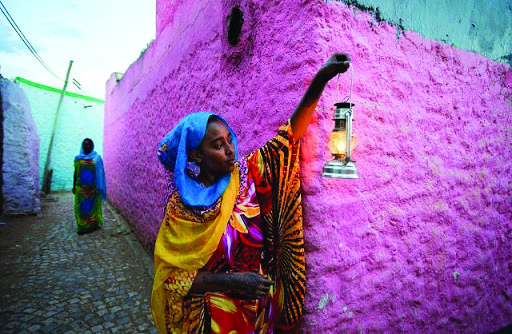

The city of Harar is located on a hilltop in the eastern extension of the Ethiopian Highlands, about five hundred kilometres from the capital Addis Ababa. The population includes the local Hareri (Adere), who speak a Semitic language and have literature written in Arabic script, as well as the Amhara, Oromo, and Somalis.
Writings show that in the 7th century AD immigrants from Hadramawt in southern Arabia were the first settlers of Harar. Yahyá Nasrallāh’s Fath Madīnat Harar, an unpublished history of the city in the 13th century, records the accounts of the qadi Abadir Umar Ar-Rida, a well-documented patron saint of Islam who has spread the religion throughout Ethiopia and Somalia along with several other religious leaders settled in Harar after he migrated from southern Arabian Hijaz Province in 1216 (612 AH). Harar was later made the new capital of the Muslim Adal Sultanate in 1520 by the Sultan Abu Bakr ibn Muhammad.
Ideally situated between the Ethiopian highlands to the west and the shores of the Gulf of Aden to the east, Harar became a crossroad for trade and culture between Africa, India and the Middle East as well as a gateway for the spread of Islam into the Horn of Africa. The city evolved into a centre of Islamic scholarship and culture and eventually was considered a sort of capital city of Islamic northeast Africa.

Most notably, Harar city is known for its Jugol wall and the walled gates that are believed to be built somewhere between the 13th and 16th century. This thick, 5 m high and 3.5 km long Jugol wall was built as a defensive response to the people of the city in the medieval times. The old town is surrounded by this fascinating wall with five famous gates scattered in all four corners-Showa Gate,
Buda Gate Sanga Gate, Erer Gate and Fallana Gate, each providing five pathways into five different quarters of the city, as well as Harar Gate, also known as Duke’s Gate after Ras Makonnen, the first duke of Harar (later Emperor Haile Selassie), who added it in 1889.
The Jugol wall surrounding the sacred city numbers 82 mosques, three of which date from the 10th century and 102 shrines. Harar is often referred to as the fourth-holiest city in Islam and known in Arabic as Madeenat-ul-Awliya (the City of Saints).
This fortified historic town of Harar, the Harar Jugol, was listed as a UNESCO World Heritage Site in 2006. The UNESCO hails the city as a “rare example of a relatively well-preserved historic town that has retained its traditions, urban fabric, and rich Harari Muslim cultural heritage to the present time”.
If there is any other thing Harar is famous for in addition to its history and architecture is the presence of the spotted hyenas roaming around the outskirts of the city. For centuries, people in
Harar have lived side by side with hyenas - one of the world’s deadliest land predators, and feeding them every year on the Day of Ashura. According to written records and local folklore, people started to feed hyenas as a way to lure them from attacking humans and eating their livestock.
Harar is also famous for its special variety of coffee beans, particularly known as Harar Coffee, which is known for its distinctive aroma and flavour.
When in Harar, It’s easy to feel lost, both geographically and in time. The people of Harar known for their warm hospitality and friendliness have a reputation of having a laid back lifestyle with a strong sense of sociability. They say “Harar is a place where you start a conversation with a stranger and end up in their friend’s house for an afternoon session”.
Oman Observer is now on the WhatsApp channel. Click here



